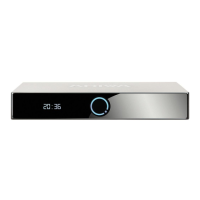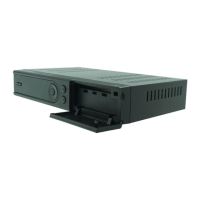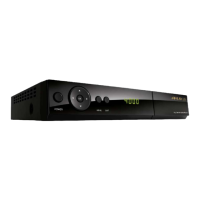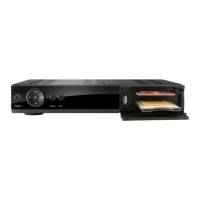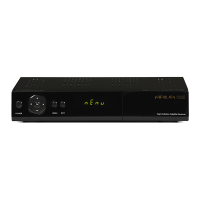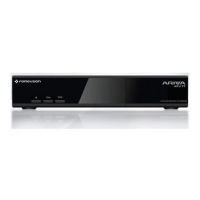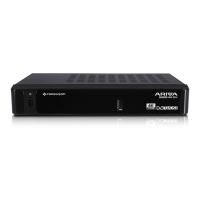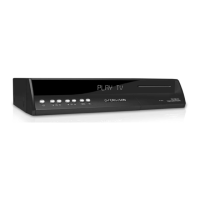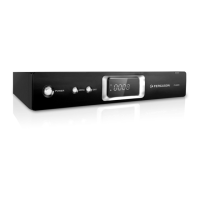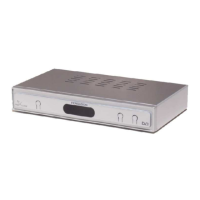Do you have a question about the Ferguson ARIVA 200 and is the answer not in the manual?
Essential safety precautions for using the receiver and avoiding hazards.
Information on obtaining the latest software updates for the receiver.
Details about the manual's purpose, limitations, and rights reserved by the manufacturer.
Explanation of logos and symbols found on the receiver and their meanings.
Overview of the key capabilities and functionalities of the satellite receiver.
Overview of the key capabilities and functionalities of the satellite receiver.
Lists the items included in the receiver's packaging.
Guidance on proper handling and interaction with the receiver's interface.
Detailed explanation of each button and its function on the RCU640 remote.
Detailed explanation of each button and its function on the RCU640 remote.
Describes the purpose and operation of various remote control buttons.
Step-by-step guide on how to install batteries in the remote control unit.
Identifies and explains the function of buttons and ports on the front panel.
Identifies and explains the function of buttons and ports on the front panel.
Instructions for inserting and using a CAM module with a subscriber's card.
Details the various ports and connectors available on the rear of the receiver.
Details the various ports and connectors available on the rear of the receiver.
Guidance on correctly connecting and positioning the satellite antenna for optimal reception.
Instructions for connecting an antenna system that includes a positioner, covering USALS.
Instructions for connecting the receiver to a TV and other devices.
Guide to connecting the receiver to a TV using an HDMI cable for high-quality output.
Instructions for connecting the receiver using component video (YPrPb) and audio cinch cables.
Guide for connecting the receiver to a TV using SCART cables.
How to connect external audio systems using digital or analog cinch connections.
Instructions for connecting USB hard drives or flash memories for recording and playback.
How to connect another satellite receiver to the LNB OUT socket, with a warning.
Guide for connecting the receiver to a local network using an RJ45 cable.
Instructions for connecting the receiver to a computer using an RS232 serial cable.
Basic steps for initial setup, including connecting power and selecting AV source.
Explains how to navigate menus using arrow keys, OK, and EXIT buttons.
Explains how to navigate menus using arrow keys, OK, and EXIT buttons.
Overview of the main menu structure and its six primary sections.
Used to set antenna installation parameters and search for channels on a satellite.
Configuration options for fixed antennas versus antennas with positioners.
How to select and mark satellites for use by the receiver.
Detailed parameter settings for selected satellites, including converter type and LNB settings.
How to search for channels on a single selected satellite, with different scan modes.
Procedure for searching channels across multiple satellites automatically.
Managing transponder frequencies for manual channel searching.
Step-by-step guide to searching for new channels using transponder data.
Configuration of receiver language, TV system, display, and time settings.
Setting the menu, audio, and subtitle languages, plus Teletext character set.
Adjusting video resolution, aspect ratio, video output, and digital audio format.
Adjusting brightness, contrast, and color saturation of the displayed image.
Setting the receiver's date and time, including GMT offset and summer time.
Enabling parental controls, locking menus/channels, and changing the password.
Customizing on-screen display parameters like subtitle display and transparency.
Specifying which TV or radio channel the receiver defaults to on startup.
Adjusting remaining system options like LNB power and channel change behavior.
Access to system information, settings restoration, and software updates.
Viewing receiver software version and database details.
Restoring the receiver to its default factory settings, including channel lists.
Instructions for updating software or settings via an RS232 serial connection.
Obtaining information about the CAM conditional access module in the CI socket.
Displaying information about the subscriber's card in the card reader.
Updating receiver software using a USB memory device.
Configuring IP addresses, subnet masks, and DNS servers for the Ethernet port.
Updating receiver software over the internet via FTP or other network protocols.
Information about the three pre-installed games: Tetris, Othello, and Sudoku.
Configuration of recording preferences, storage information, and timer settings.
Displays information about connected USB storage and allows formatting.
Adapting recording preferences, including Timeshift and buffering settings.
Programming up to 32 events for automatic recording or channel switching.
Playing music, photos, videos, and recordings using the receiver's player.
Playing music files (MP3, OGG) using the receiver's multimedia player.
Viewing photographs in JPEG format, with options for playback.
Playing back video files in MPG format using the media player.
Playing back recorded content, with options for blocking, naming, or deleting.
Safely removing USB memory devices to prevent data loss.
Managing TV and radio channel lists, including moving, deleting, and favorites.
Editing the TV channel list, including moving channels using colored buttons.
Step-by-step instructions on how to change the position of a channel in the list.
Step-by-step instructions for deleting individual TV channels from the list.
Guide on adding channels to favorite groups using the FAV button.
Procedure for renaming TV channels using the remote control's numerical keyboard.
Editing the list of radio channels using the remote control's colored buttons.
Option to remove all channels from the channel list, with a warning about irreversibility.
Defining and renaming up to 32 different favorite channel groups.
Overview of essential remote control functions like EPG, FIND, and INFO.
Displays program information and allows scheduling viewing/recording.
Quick channel search function using letter input for fast channel finding.
Displays teletext pages broadcast by the selected TV station.
Selecting available audio soundtracks for channels or recordings.
Selecting available on-screen captions or subtitles for channels or recordings.
Recording the current channel to a USB device, with duration settings.
Allows watching a different channel on the same transponder during recording.
Pausing live TV broadcast and resuming later using the time shift buffer.
How to record the existing buffer content and continue recording the channel.
Steps to disable the time shift mode using the STOP button.
Displays current and next program information, and signal parameters.
Accessing favorite channel groups created by the user.
Definitions of technical terms and acronyms used throughout the manual.
Instructions for programming the universal remote control for TV operation.
Method to program the remote for TV control using specific brand codes.
Using an automatic search function to find the correct TV code for the remote.
Step-by-step guide for manually programming the remote control for TV operation.
How to retrieve the currently programmed TV code from the remote control.
Procedure to delete all programmed TV settings from the remote control.
A comprehensive list of codes for programming the universal remote control with various TV brands.
Instructions for programming the universal remote control version 2 for TV operation.
Method to program the remote for TV control using brand name search.
Using an automatic search function to find the correct TV code for the remote.
Programming the remote control using specific 4-digit brand codes.
Manually searching for TV codes by repeatedly pressing the VOL+ button.
Adding new remote control codes from an original remote to the RCU-640.
How to view the currently programmed TV code on the remote control.
Key specifications of the STB type and main chipset.
Details on encryption, tuner, demodulator, and power supply type.
Physical dimensions and weight of the satellite receiver.
Information about the primary chipsets used in the receiver.


